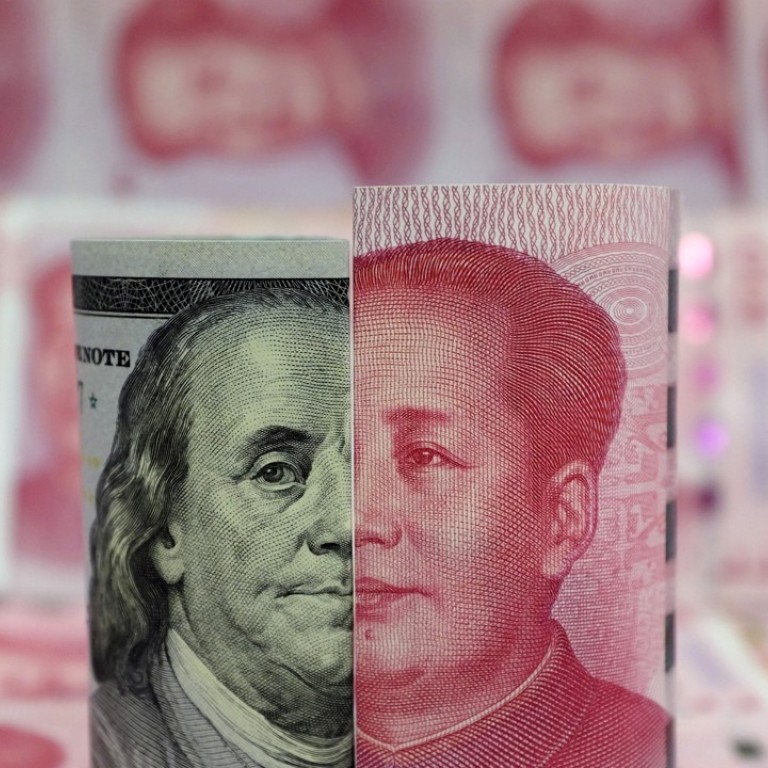
China’s forex reserves hit 18-month low as trade war piles pressure on yuan
- China’s currency reserves fall by about US$34 billion in October as central bank defends yuan from excess depreciation
- Drop still modest compared with declines during 2015 market rout
China’s foreign exchange reserves fell more than expected in October to a 18-month low, suggesting a gradual pickup in capital outflow pressure amid the trade war with the United States.
The reserves fell US$33.93 billion in October to US$3.053 trillion, versus a decline of US$22.69 billion in September, central bank data showed on Wednesday. A Bloomberg survey of economists forecast a drop of US$28.53 billion to US$3.06 trillion.
The modest depletion in the reserves comes as the yuan has lost 10 per cent of its value to the US dollar since February. Still, last month’s drop was small compared with the monthly declines of more than US$100 billion that occurred in 2015 to stem the stronger capital outflows at that time, suggesting that while capital outflows may be picking up, there has been no market panic yet.
“The combination of exchange rate conversion and asset price changes has led to a slight decline in the size of foreign exchange reserves,” the State Administration of Foreign Exchange said in a statement, adding that continued upgrades to China’s economy combined with a further opening up of its markets will be conducive to steady cross-border capital flows.
Transactions of offshore renminbi soar in forex markets even as Trump slams China on currency
While Chinese policymakers have been less interventionist in defending the yuan than they were in 2015, they may still be using the dollar reserves to buy yuan in the spot market to slow the pace of the currency’s depreciation and keep market confidence broadly contained.
Sheng Songcheng, a senior adviser to the People’s Bank of China, said last month that China should use its forex reserves to stabilise the yuan’s exchange rate when needed.
Data show that growth in the Chinese economy has slowed over the past four quarters, and analysts expect it to slow further over the next four quarters, putting more downward pressure on the currency.
Iris Pang, Greater China economist at ING Bank, said Beijing might let the yuan gradually fall below the psychologically important 7.00 level by year end, especially if the meeting between Chinese President Xi Jinping and US President Donald Trump at the G20 failed to stop the proposed increase in tariffs on US$200 billion of Chinese goods from 10 per cent to 25 per cent, a rise is expected to go into effect on January 1.
On Wednesday, the onshore yuan, which is traded in China, dropped 0.04 per cent to 6.9221 against the dollar while the offshore yuan, which is traded outside the mainland, rose 0.11 per cent to 6.9166.
The value of China’s gold reserves stood at US$71.968 billion at the end of October, up from US$70.327 billion at the end of September, central bank data showed.
The US midterm elections resulted in a setback for Trump, with the Democrats regaining control of the House of Representatives. However, the Republicans expanded their majority in the Senate.
But a change of leadership in the House is not likely to have much effect on Trump’s trade policies and the tensions they have caused, according to consultancy AllianceBerstein. This is because Congress has over the years delegated much of its trade authority to the executive branch.
PBOC takes aim at yuan shorts, raises forex reserve requirement to 20 per cent after currency tumbles to 15-month low
Cliff Tan, East Asian head of global markets research at MUFG Bank, said in a recent research note that he expected larger reserve losses, further yuan depreciation pressure and a tightening of capital controls because underlying credit problems in China were not being resolved.
China’s local governments might have accumulated 40 trillion yuan (US$5.8 trillion) worth of “hidden debt” that is not reflected in official figures, “a debt iceberg with titanic credit risks” for the world’s second-biggest economy, S&P Global Ratings said in a report last month.
“For the first time, we are beginning to wonder if even China Inc has enough money to paper over problems one more time,” Tan said.

